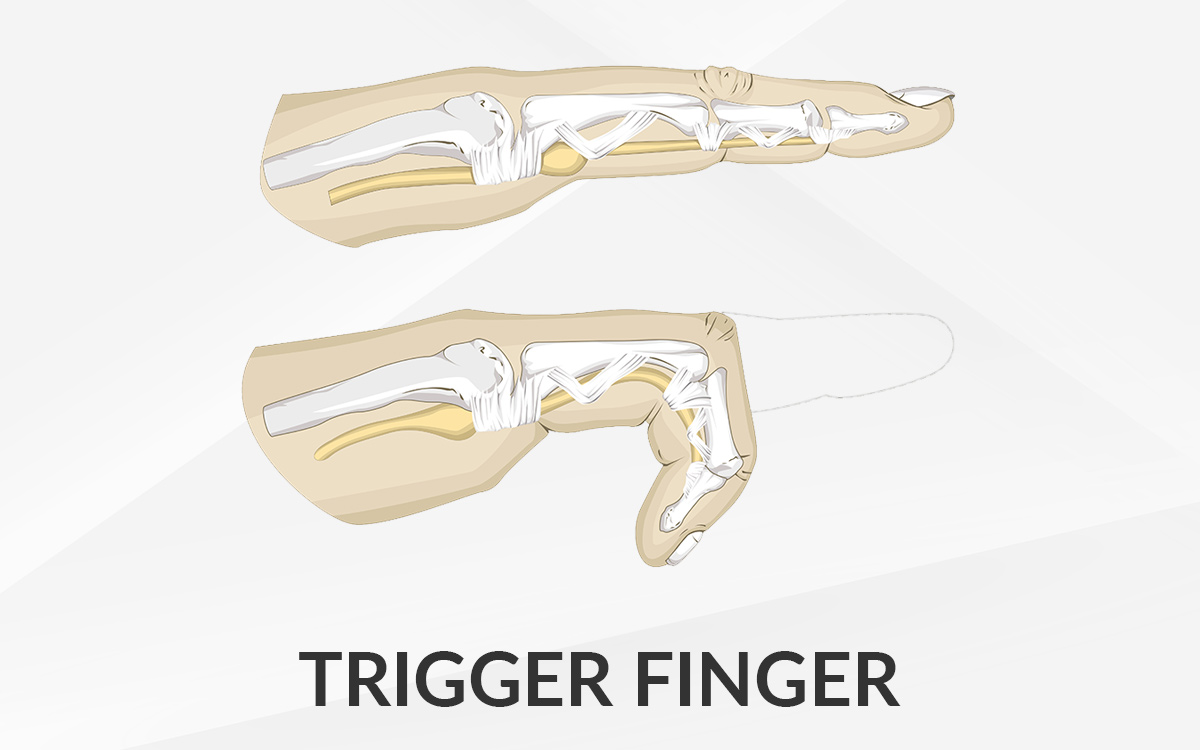
Summary
Affects
- Ring finger
- Thumb
Causes
- Diabetes
- Rheumatoid arthritis
- Associated with Carpal Tunnel Syndrome
- Associated with De Quervain’s Tenosynovitis
Symptoms
- Thumb or finger feel like
- Clicking
- Catching
- Stay bent/locked
- Pain and soreness in palm or fingers
Treatment
- Mild cases can be treated with splints, steroid injections and hand therapy
- Severe cases need surgery
What is a Trigger Finger/Thumb and its causes?
Trigger Finger or Thumb is a term used to describe the clicking, catching, locking of a finger or a thumb as you bend and straighten it. It is caused by inflammation and thickening of the pulley or tendon sheath around the tendon which bends your finger or thumb. Inflammed tendon gets trapped in the pulley leading to locking of the finger or thumb.
The ring finger and thumb is commonly affected. It happens in the age group below 6 years and then between the ages of 40 and 60 years. Women are affected more than men.
The exact cause is not known but it can happen in patients with diabetes, rheumatoid arthritis, associated with carpal tunnel syndrome and with De Quervain’s Tenosynovitis etc.
What are the symptoms of Trigger Finger or Thumb?
It may feel like your finger or thumb is clicking, catching or may stay bent/locked. Sometimes the only way to straighten your finger is by straightening it using your other hand.
At other times it can be sore and painful especially when direct pressure is placed over the thickening in the palm of your hand. More than one finger can be affected at a time by this condition.
How is it diagnosed?
Your surgeon will examine your affected finger and hand and assess for the pain on the thickening in the palm in your hand along with finger movements.
Why should I have Trigger Finger or Thumb released?
If it is left untreated, the affected finger or thumb may get permanently locked in a bent position. This will stop you from performing normal daily activities.
What are the options for treatment?
Mild cases can be treated with splints, steroid injections and hand therapy. However, in severe cases or where, conservative treatment fails or in a locked finger or in a congenital trigger thumb it will have to be surgically released.
What does the surgery involve?
It is done as a day case under a local anaesthetic. The surgeon will make a small cut of around 1-1.5cm and release the tight pulley. The surgeon will then check that the tendon and finger moves smoothly. You will have some skin stitches and will go home the same day.
What are the risks with the surgery?
Overall the risks are very small and include infection, scar which may be tender for 6-8 weeks, damage to the blood vessel or nerve supply to the digits, stiffness ( this is temporary in most of the cases ), inadequate release, temporary soreness and swelling at the site of the surgery.
What should I look out for at home?
Swelling – which you can prevent or reduce by elevating your arm or placing it on a couple of pillows when you are sitting or resting.
You will have a padded dressing which can be reduced in 2-3 days. You will be seen back in clinic in 2 weeks’ time for removal of stitches. Please do not let your hand get wet in this time. If necessary cover it with a plastic bag tied at the wrist or a large rubber glove.
You may be asked to attend hand therapy for a splint or exercises. These appointments will be given to you before you leave the hospital on the day of your surgery.
Are there any alternatives to surgery?
Steroid injections can be given in clinic or under ultrasound scan at the site of the tendon sheath swelling. The injection takes 7 to 10 days to work. This generally causes no side effects but occasionally can cause thinning of the skin or loss of skin colouring at the site of the injection. Even if these steroid injections work initially, triggering can always come back. This is less common with surgery. The results of the operation are normally excellent with a success of around 98% with very few complications.
When can I return to driving and work?
It depends on the nature of work. It normally takes around three weeks if your job involves more physical work.
BMI Chelsfield Park Hospital
Bucks Cross Road Chelsfield ORPINGTON BR6 7RG
01689 877855
BMI The Blackheath Hospital
40-42 Lee Terrace Blackheath LONDON SE3 9UD
020 8318 7722
BMI The Sloane Hospital
125 Albemarle Road BECKENHAM BR3 5HS
020 8466 4000
Princess Royal University Hospital
Farnborough Common ORPINGTON BR6 8ND
01689 863223



